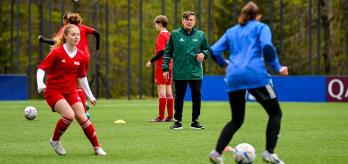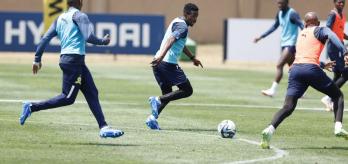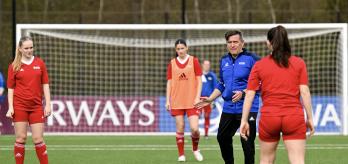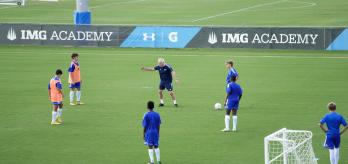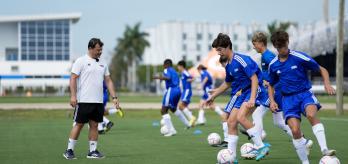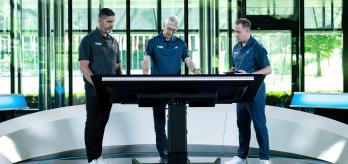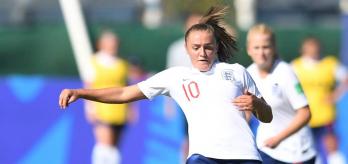It is vital that young players experience the joy of seeing the ball hit the back of the net and understand the process involved in creating goalscoring chances, which should ultimately foster a desire in them to score more goals. Exposing players to a range of scenarios that tap into their creativity and individuality enables them to develop a desire to score goals from all areas of the pitch.
In this session, FIFA Technical Expert Jonas Urias delivers a series of exercises to a group of young girls. The objective of the session is to give the players the confidence to score in a range of scenarios. The session begins with a cognitive exercise in which the players are invited to talk about their most spectacular goal/assist before moving on to work on a finishing exercise that acts as a warm-up. Part 2 involves a small-sided 5v3 game that focuses on creating goalscoring chances, while parts 3 and 4 of the session give the players the opportunity to create goalscoring chances in real-game scenarios.
Session overview
Key coaching points
-
Encourage players to showcase their creativity, to take advantage of goalscoring chances and to shoot whenever the chance presents itself.
-
If players are not in good goalscoring positions, they should consider how they can create chances for their team-mates.
-
Look to create numerical advantages to improve the team’s chances of engineering goalscoring opportunities.
-
Implement a points system that rewards players for scoring spectacular goals and gives their team a greater chance of winning the game.
Introduction: cognitive preparation
Before the players take to the pitch to perform the exercises, gather them together and ask them to reflect on the most spectacular goal that they have ever scored or the finest assist that they have provided.
-
Ask the players to take a coloured pen and draw a picture of, or write the words that they associate with, their most spectacular goal/assist on the flip chart.
-
Encourage the players to tell their team-mates and coach about their goal/assist.
-
Ask the players to take this memory with them onto the pitch and recreate the goal/assist or use it to inspire them to register a different kind of goal/assist.
Part 1: finishing warm-up
The first exercise is designed to give players the opportunity to work on their close-range finishing, including volleys and headers. Players are asked to take the skills that they work on in this warm-up into the following exercises.
-
Mark out a 20x15m exercise area.
-
Place a full-size goal at each end of the exercise area.
-
Position a goalkeeper in each goal.
-
Split the group into two teams (blues and oranges).
-
Place a red cone in the middle of the exercise area.
-
Line the blue team up on the right edge of the exercise area.
-
Line the orange team up on the left edge of the exercise area.
-
Give each team two balls.
-
The player at the front of both lines runs around the red cone in the centre of the exercise area and faces the goal into which they will shoot.
-
Once the player at the front of the line has run around the red cone, the player at the back of the line throws or rolls the ball into a goalscoring area for them.
-
The player takes a touch to receive the ball before finishing on goal with their second touch.
-
The player who has just taken the shot collects their ball and joins the back of their team’s line to become the next passer.
-
The sequence is repeated.
Variation 1
-
The shooters have to finish first-time.
-
Both teams are encouraged to count the number of goals that they score.
Variation 2
-
Instead of throwing or rolling the ball to the shooter, the passer plays the ball along the ground to the shooter using their feet.
-
The shooter must shoot from a position between the red cone and the far post.
-
The shooter can take as many touches as they want.
Variation 3
-
The passer serves a high ball into the shooter using their feet.
-
The shooter must finish first-time with a volley or header.
-
Encourage players to use a range of finishing techniques to build up their confidence in readiness for the exercises later on in the session.
-
Place shots either side of the goalkeeper to increase the chances of scoring, which ultimately boosts confidence.
-
Adopt the right footwork in preparation for a finish on goal.
Part 2: 5v3 plus Goalkeepers
This exercise focuses on the players developing an eye for goal and for them to take goalscoring chances when they present themselves. Attacking players should be encouraged to recognise when the opposition offer them spaces and opportunities to exploit.
-
Mark out a 30x20m exercise area.
-
Place a full-size goal at each end of the exercise area.
-
Position a goalkeeper in each goal.
-
Mark out a line at both ends of the exercise area to represent the edge of the penalty area.
-
Split the group into two teams of 7.
-
Place 5 orange players and 3 blue players inside the exercise area.
-
All remaining players wait behind their team’s goal.
-
This attack v. defence exercise begins with the orange team in possession.
-
The blue team act as the defending team.
-
If a goal is scored or the ball goes out of play, the orange team quickly transition to attack the goal at the opposite end of the exercise area and the blue team transition quickly to defend the goal at the opposite end of the exercise area.
-
The offside rule applies in this exercise.
-
Once an attack has been completed or a goal has been scored in both directions, rotate the players, with the players waiting behind their team’s goal now involved in the exercise.
-
Encourage players to score different types of goals by introducing the following points system:
-
A goal scored from outside of the penalty area is awarded three points.
-
A goal scored from inside the penalty area is awarded one point.
-
An extra point is awarded if a goal is scored following an assist.
-
-
If the opposition offer spaces or opportunities to exploit, it is important that attacking players recognise them and use them to score.
-
The attacking team should capitalise on of their numerical advantage to work clear goalscoring chances from a range of areas.
-
Keep the ball moving and use the space to work good shooting angles.
Part 3: 7v3 plus 4 outside players and Goalkeepers
This exercise focuses on repeatedly getting players into goalscoring situations. One of the two teams can only finish on goal following a cross delivered by a player positioned outside the exercise area, whilst the other team must either shoot from outside the penalty area or finish first-time following a through-ball played by a team-mate.
-
Mark out a 50x20m exercise area.
-
Place a full-size goal at each end of the exercise area.
-
Position a goalkeeper in each goal.
-
Split the exercise area into thirds.
-
Divide the group into two teams of 7.
-
Place all 7 orange-team players inside the middle third.
-
Place three blue-team players inside the middle third.
-
Arrange the 4 remaining blue-team players outside the exercise area.
-
The coach serves the ball into the middle third for possession to be contested by the two teams.
-
The orange team can only score with shots taken from outside the penalty area or by playing a pass into the penalty area to a team-mate, who is the only player allowed in the penalty area and has to finish first-time.
-
The orange team can attack either goal.
-
The blue team can only score by passing the ball to one of the four outside players and then running into the penalty area to meet the cross delivered by the outside player.
-
One orange-team player is allowed to drop back into the penalty area to defend, creating a 3v1 overload in favour of the blue team.
-
The blue team must attack the goal closest to the outside player to whom they decide to pass the ball.
-
Swap teams so that each player gets to experience all aspects and scenarios within the exercise.
-
The goalkeepers serve the ball into the middle third by kicking it out of their hands.
-
Ask the players to take up different positions within the penalty area in the 3v1 scenario to increase the chances of finishing on goal and to make the most of crossing opportunities.
-
Look to create goalscoring chances at every opportunity. The more the ball is played into wide players or in behind, the more chances will be created within the exercise.
-
Passes and crosses played into attacking team-mates should be played into the right areas to allow them to finish accurately on goal.
Part 4: 7v7 plus Goalkeepers
This final exercise allows players to put all of the skills acquired in the previous exercises into practice in a real-game situation, in which players are given the opportunity to finish on goal from a range of areas and distances.
-
Mark out a 40x20m exercise area.
-
Place a full-size goal at each end of the exercise area.
-
Position a goalkeeper in each goal.
-
Mark out the edge of the penalty area 15m from the goal line at both ends of the exercise area.
-
Place a number of balls around the edge of the exercise area.
-
Set up a 7v7 game inside the exercise area.
-
The aim for both teams is to score in the opposition’s goal.
-
A goal scored from inside the marked penalty area is awarded two points.
-
A “special goal” is awarded five points. The coach judges whether a goal comes under this category.
-
The offside rule applies in this exercise.
-
Players restart play with a throw-in if the ball goes out of play.
-
Increase the width of the exercise area by 5m on either side.
-
Allow players to play freely and encourage them to use their creativity to score different kinds of goals.
-
Face the opposition’s goal at all times and shoot on sight.
-
If it is not possible to take a shot on goal, pass or dribble to create space for team-mates to shoot.
















